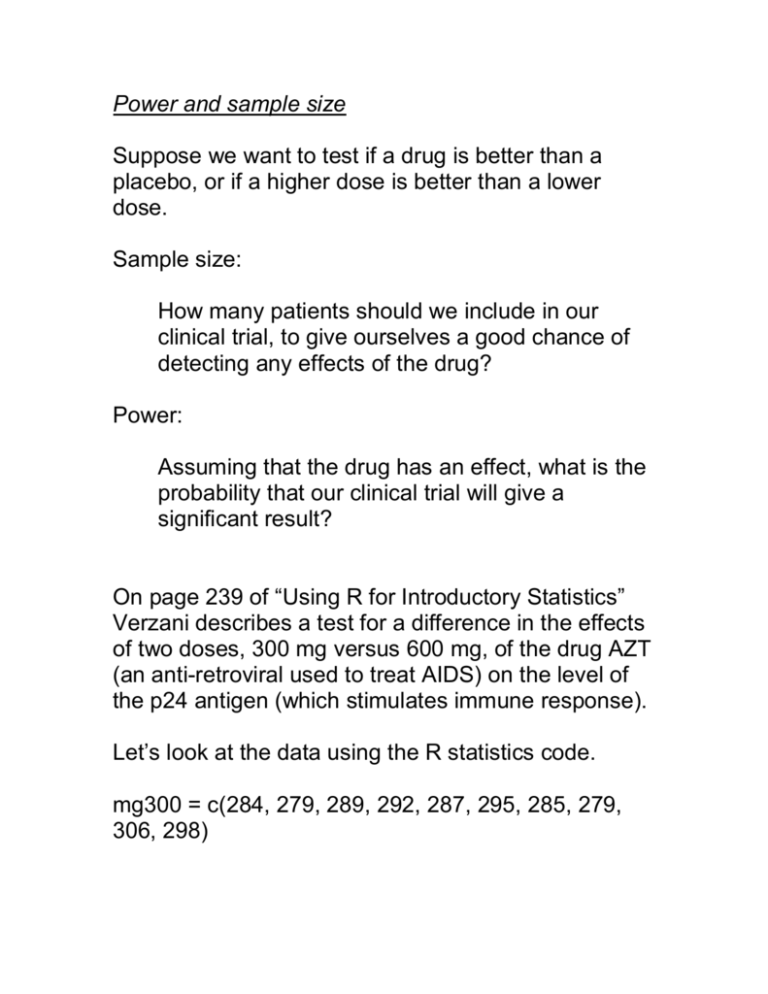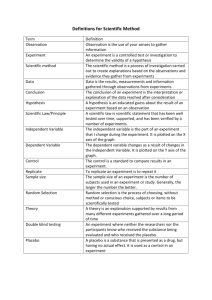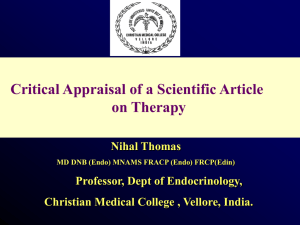Data Analysis for Bioinformatics:
advertisement

Power and sample size
Suppose we want to test if a drug is better than a
placebo, or if a higher dose is better than a lower
dose.
Sample size:
How many patients should we include in our
clinical trial, to give ourselves a good chance of
detecting any effects of the drug?
Power:
Assuming that the drug has an effect, what is the
probability that our clinical trial will give a
significant result?
On page 239 of “Using R for Introductory Statistics”
Verzani describes a test for a difference in the effects
of two doses, 300 mg versus 600 mg, of the drug AZT
(an anti-retroviral used to treat AIDS) on the level of
the p24 antigen (which stimulates immune response).
Let’s look at the data using the R statistics code.
mg300 = c(284, 279, 289, 292, 287, 295, 285, 279,
306, 298)
mg600 = c(298, 307, 297, 279, 291, 335, 299, 300,
306, 291)
plot(density(mg300))
lines(density(mg600), lty=2)
t.test(mg300, mg600, var.equal=TRUE)
Two Sample t-test
data: mg300 and mg600
t = -2.034, df = 18, p-value = 0.05696
alternative hypothesis: true difference in means is not
equal to 0
95 percent confidence interval:
-22.1584072 0.3584072
sample estimates:
mean of x mean of y
289.4 300.3
Verzani [p. 240] states
“The p-value is 0.05696 for the two-sided test. This
suggests a difference in the mean values, but is not
statistically significant at the 0.05 level. A look at the
reported confidence interval for the difference of the
means shows a wide range of possible values for
[mean for 300 mg versus mean for 600 mg]. We
conclude that this data is consistent with the
assumption of no mean difference.”
If you were doing this experiment, would you
conclude that there is no difference between the
doses?
Assuming that the drug doses have a different effect,
what is the probability that our clinical trial will give a
significant result, that is, how much power did the
experiment have to detect the difference?
What sample size would be required to detect the
observed difference with alpha = 0.05?
Power for a t-test.
We plan a test to determine if a drug is more effective
than a placebo.
Power is the probability that our experiment will detect
a significant difference between the treatment groups,
assuming that there is a real difference, that is, we
assume that the drug is more effective than placebo.
Note that power makes the opposite assumption from
the usual case, that is, we usually assume that there
is no difference between treatment groups.
For clinical trials and biology experiments, we typically
aim for power of 80%, 90%, or higher.
A simulation to illustrate power and sample size
Suppose that we have the following situation.
We have a drug that lowers mean blood pressure by
10 units. We have two populations:
# A population of 1000 patients who receive a
placebo, mean BP = 150, standard deviation = 20
placebo= rnorm(1000, 150, 20)
hist(placebo)
# A population of 1000 patients who receive a drug to
reduce blood pressure, mean BP = 140, standard
deviation = 20
drug = rnorm(1000, 140, 20)
hist(drug)
# Plot the two populations.
plot(density(placebo), xlim= c(50, 250),ylim=c(0,.025))
lines(density(drug), lty=2)
# Take sample of size n = 30
placebo.sample = sample(placebo, size=30)
drug.sample = sample(drug, size=30)
# Plot the two samples
plot(density(placebo.sample), xlim= c(50,
250),ylim=c(0, .025))
lines(density(drug.sample), lty=2)
# T test
t.test(placebo.sample, drug.sample, var.equal=TRUE)
ttest.result = t.test(placebo.sample, drug.sample,
var.equal=TRUE)
ttest.result$p.value
# What is the probability that we will detect a
significant difference (p < 0.05) if we take many
samples of size n=30 ? Do a simulation of 1000
samples and t-tests, and look at the distribution of pvalues.
rm(pvalue.list)
n = 30
pvalue.list = c()
for (i in 1:1000)
{
placebo.sample = sample(placebo, size=n)
drug.sample = sample(drug, size=n)
pvalue.list[i] = t.test(placebo.sample, drug.sample,
var.equal=TRUE)$p.value
pvalue.list
}
# Plot the pvalue.list
hist(pvalue.list, xlim= c(0, 1), breaks=seq(0,1,.05),
ylim=c(0,1000))
# What percent of the 1000 simulated samples give a
p-value less than 0.05?
pctLT05=100*sum(sort(pvalue.list)<.05)/length(pvalue
.list)
cat(pctLT05, "% of the 1000 simulated samples give
a p-value less than 0.05\n")
cat("The simulation indicates that we have ", pctLT05,
"% power.\n")
cat("The probability that we will detect a significant
difference (p < 0.05) if we take many samples of size
n=30 is ", pctLT05/100, ".\n")
#### If we increase sample size we increase power.
# What is the probability that we will detect a
significant difference (p < 0.05) if we take many
samples of size n=50 ? Do a simulation of 1000
samples and t-tests, and look at the distribution of pvalues.
n = 50
pvalue.list = c()
for (i in 1:1000)
{
placebo.sample = sample(placebo, size=n)
drug.sample = sample(drug, size=n)
pvalue.list[i] = t.test(placebo.sample, drug.sample,
var.equal=TRUE)$p.value
pvalue.list
}
# Plot the pvalue.list
hist(pvalue.list, xlim= c(0, 1), breaks=seq(0,1,.05),
ylim=c(0,1000))
# What percent of the 1000 simulated samples give a
p-value less than 0.05?
pctLT05=100*sum(sort(pvalue.list)<.05)/length(pvalue
.list)
cat(pctLT05, "% of the 1000 simulated samples give
a p-value less than 0.05\n")
cat("The simulation indicates that we have ", pctLT05,
"% power.\n")
cat("The probability that we will detect a significant
difference (p < 0.05) if we take many samples of size
n=50 is ", pctLT05/100, ".\n")
######## If we decrease the population variance, we
increase power.
Suppose that we set eligibility criteria for entering the
clinical trial so that we include only patients who are
within a certain age range, who have never taken a
blood pressure medication, and who do not have
other medical conditions that affect blood pressure.
We would likely get a group with lower population
variance.
# A population of 1000 patients who receive a
placebo, mean BP = 150, standard deviation = 10
placebo= rnorm(1000, 150, 10)
hist(placebo)
# A population of 1000 patients who receive a drug to
reduce blood pressure, mean BP = 140, standard
deviation = 10
drug = rnorm(1000, 140, 10)
hist(drug)
# Plot the two populations.
plot(density(placebo), xlim= c(50, 250), ylim=c(0, .05))
lines(density(drug), lty=2)
# Take sample of size n = 30
placebo.sample = sample(placebo, size=30)
drug.sample = sample(drug, size=30)
# Plot the two samples
plot(density(placebo.sample), xlim= c(50, 250),
ylim=c(0, .05))
lines(density(drug.sample), lty=2)
# T test
t.test(placebo.sample, drug.sample, var.equal=TRUE)
ttest.result = t.test(placebo.sample, drug.sample,
var.equal=TRUE)
ttest.result$p.value
# What is the probability that we will detect a
significant difference (p < 0.05) if we take many
samples of size n=30 ? Do a simulation of 1000
samples and t-tests, and look at the distribution of pvalues.
n = 30
pvalue.list = c()
for (i in 1:1000)
{
placebo.sample = sample(placebo, size=n)
drug.sample = sample(drug, size=n)
pvalue.list[i] = t.test(placebo.sample, drug.sample,
var.equal=TRUE)$p.value
pvalue.list
}
# Plot the pvalue.list
hist(pvalue.list, xlim= c(0, 1), breaks=seq(0,1,.05),
ylim=c(0,1000))
# What percent of the 1000 simulated samples give a
p-value less than 0.05?
pctLT05=100*sum(sort(pvalue.list)<.05)/length(pvalue
.list)
cat(pctLT05, "% of the 1000 simulated samples give
a p-value less than 0.05\n")
cat("The simulation indicates that we have ", pctLT05,
"% power.\n")
cat("The probability that we will detect a significant
difference (p < 0.05) if we take many samples of size
n=30 is ", pctLT05/100, ".\n")
###### Power increases as the effect size increases
Effect size is the difference between the means of the
two groups.
If we have a more effective drug, the difference
between the means of the two groups will increase,
so the effect size increases, and power increases.
# A population of 1000 patients who receive a
placebo, mean BP = 150, standard deviation = 20
placebo= rnorm(1000, 150, 20)
hist(placebo)
# A population of 1000 patients who receive a drug to
reduce blood pressure, mean BP = 130, standard
deviation = 20
drug = rnorm(1000, 130, 20)
hist(drug)
# Plot the two populations.
plot(density(placebo), xlim= c(50, 250), ylim=c(0,
.025))
lines(density(drug), lty=2)
# Take sample of size n = 30
placebo.sample = sample(placebo, size=30)
drug.sample = sample(drug, size=30)
# Plot the two samples
plot(density(placebo.sample), xlim= c(50, 250),
ylim=c(0, .025))
lines(density(drug.sample), lty=2)
# T test
t.test(placebo.sample, drug.sample, var.equal=TRUE)
ttest.result = t.test(placebo.sample, drug.sample,
var.equal=TRUE)
ttest.result$p.value
# What is the probability that we will detect a
significant difference (p < 0.05) if we take many
samples of size n=30 ? Do a simulation of 1000
samples and t-tests, and look at the distribution of pvalues.
n = 30
pvalue.list = c()
for (i in 1:1000)
{
placebo.sample = sample(placebo, size=n)
drug.sample = sample(drug, size=n)
pvalue.list[i] = t.test(placebo.sample, drug.sample,
var.equal=TRUE)$p.value
pvalue.list
}
# Plot the pvalue.list
hist(pvalue.list, xlim= c(0, 1), breaks=seq(0,1,.05),
ylim=c(0,1000))
# What percent of the 1000 simulated samples give a
p-value less than 0.05?
pctLT05=100*sum(sort(pvalue.list)<.05)/length(pvalue
.list)
cat(pctLT05, "% of the 1000 simulated samples give
a p-value less than 0.05\n")
cat("The simulation indicates that we have ", pctLT05,
"% power.\n")
cat("The probability that we will detect a significant
difference (p < 0.05) if we take many samples of size
n=30 is ", pctLT05/100, ".\n")
How to calculate power and sample size
To calculate power, we need to specify the following:
Effect size: what is the difference between the
means of the two treatment groups?
Standard deviation: the average standard
deviation of the two treatment groups.
Sample size: how many subjects will be in each
group?
Sample size for a t-test is the number of subjects we
need in each group. To calculate sample size we
need to specify the following:
Effect size: what is the difference between the
means of the two treatment groups?
Standard deviation: the average standard
deviation of the two treatment groups.
Power: what power do we want the test to have,
e.g., 80% power?
Commercial statistics software can calculate power
and sample size:
NCSS PASS
Statistica
Glantz, Primer of Biostatistics
nQuery
See Chapters 6, in Glantz, Primer of Biostatistics.
What does “Not significant” really mean?
On the walkerbioscience.com web site, see
the Excel file, “Statistics in 1 hour”, worksheets
“sample size & power concepts”
“sample size for ttest”
R functions for power calculation
help(power.t.test)
power.t.test(n = NULL, delta = NULL, sd = 1, sig.level
= 0.05, power = NULL, type = c("two.sample",
"one.sample", "paired"),alternative = c("two.sided",
"one.sided"), strict = FALSE)
n: Number of observations (per group)
delta: True difference in means
sd: Standard deviation
See also help(power.prop.test)
Estimate sample size for a two-sample t-test
# difference in means, delta = 0.5
# standard deviation, sd = 0.5
# alpha, sig.level = 0.01
# desired power, power = 0.9
power.t.test(delta = 0.5, sd = 0.5, sig.level = 0.01,
power = 0.9)
Two-sample t test power calculation
n = 31.46245
delta = 0.5
sd = 0.5
sig.level = 0.01
power = 0.9
alternative = two.sided
NOTE: n is number in *each* group
Estimate power for a two-sample t-test
# difference in means, delta = 0.5
# standard deviation, sd = 0.5
# alpha, sig.level = 0.01
# sample size, n = 31
power.t.test(delta = 0.5, sd = 0.5, sig.level = 0.01, n =
31)
Let’s return to our AZT example
mg300 = c(284, 279, 289, 292, 287, 295, 285, 279,
306, 298)
mg600 = c(298, 307, 297, 279, 291, 335, 299, 300,
306, 291)
plot(density(mg300))
lines(density(mg600), lty=2)
t.test(mg300, mg600, var.equal=TRUE)
mean(mg300)
sd(mg300)
mean(mg600)
sd(mg600)
effect.size= mean(mg300)- mean(mg600)
Estimate power for a t-test for the AZT example
# difference in means, delta = mean(mg300)mean(mg600)
# standard deviation, sd = 14
# alpha, sig.level = 0.05
# sample size, n = 10
power.t.test(delta = mean(mg300)- mean(mg600), sd
= 14, sig.level = 0.05, n = 10)
t test power calculation
n = 10
delta = 10.9
sd = 14
sig.level = 0.05
power = 0.3776173
alternative = two.sided
NOTE: n is number in *each* group
So the AZT test only had power = .377, or about a
40% probability of detecting the effect even if the drug
actually works.
Estimate sample size for the AZT example for
power=.9
# difference in means, delta = mean(mg300)mean(mg600)
# standard deviation, sd = 14
# alpha, sig.level = 0.01
# desired power, power = 0.9
power.t.test(delta = mean(mg300)- mean(mg600), sd
= 14, sig.level = 0.05, power = 0.9)









